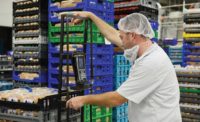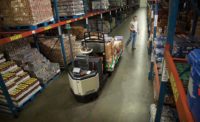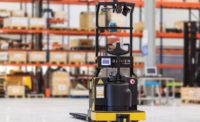Suppliers continue to improve the wide range of equipment available for warehouse management—from lift trucks to autonomous vehicles, mechanized order fulfillment and other automated systems. The goal is to streamline the safe and accurate movement of goods, from incoming supplies to the point of distribution.
Getting a lift
Traditional lift trucks have been upgraded with features that improve maneuverability and worker safety, increasing overall productivity.
Yale Materials Handling Corp., Greenville, NC, offers the Yale MPB045-VG pallet truck, which features a direct-store-delivery (DSD) option designed to preserve product integrity. Features include a lithium-ion battery, a specially designed handle, load retention strap and backrest. The handle offers complete functionality in the upright position. “All OEMs now have power steering on pallet trucks,” says Mick McCormick, vice president, warehouse solutions. “Power steering combined with the MPB045-VG’s specially designed handle improves maneuverability. From an ergonomic perspective, this can reduce steering effort and minimize operator fatigue.”
Crown Equipment, New Bremen, OH, offers the Crown FC5200 Series counterbalanced forklift, which gives operators strength and maneuverability to lift heavy loads in tight aisles and on crowded docks. The lift can support load capacities up to 6,500 lbs. “The Crown FC5200 helps operators get more done in less time, using fast acceleration, travel and lift speeds to move 10 percent more loads per shift. The tight turning radius enables the truck to be used in the same space as a conventional four-wheel forklift, while allowing room for a larger battery that provides 15 percent more runtime per charge,” says Andy Smith, director, marketing product management.
The WalkieStraddle Stacker from Toyota Material Handling U.S.A., Columbus, IN, has a 2,500-lb.capacity designed for trailer loading and unloading. It can be used in small, specialized areas within a large facility. “It is IP65-rated to help protect against dust and liquids. The AC-drive motor provides smooth acceleration, increased performance during regenerative braking and efficient power to the drive wheel,” says Tim Meyer, automation manager.
Autonomous solutions
Use of driverless vehicles in food industry warehouses is on the rise. Available technologies include: forward-looking radar with collision-mitigation capabilities, roll stability control, lane departure monitoring and correction technologies, notes Scott Perry, chief technology and procurement officer, global fleet management solutions, Ryder System, Inc., Miami. The company is evaluating the development of autonomous forklifts for use inside the warehouse.
“Technologies such as Crown’s QuickPick Remote order-picking system give the operator the ability to control the vehicle from the aisle. The system uses automated truck navigation technology to reduce low-level order-picking walk steps, thereby increasing productivity, reducing operator fatigue and improving safety,” Smith explains.
The Yale MPE080-VG with Driven by Balyo technology locates itself in real-time by comparing what the navigation laser detects to a reference map. This allows the lift truck to perceive and interact with its environment, making autonomous decisions. The system features a scalable interface that can handle regular point-to-point transportation and integrate with enterprise software to make remote route determinations. Operators can easily switch to manual mode.
OTTO Motors, a division of Clearpath, Waterloo, Ontario, offers the OTTO self-driving vehicle designed for material transport in industrial environments. It uses sensors and artificial intelligence to provide flexible automation that requires no fixed infrastructure (e.g., beacons, magnetic tape, predefined laser paths, etc.). Systems can be outfitted with different features to fit the needs of the facility, whether it be a shelf on the OTTO 100 or a lift on the OTTO 1500.
“In the food industry, the OTTO self-driving vehicle is a good fit for line-side delivery applications, whether it is bringing work in progress goods to primary packaging, transporting goods from primary to secondary packaging, or moving finished products from secondary packaging into inventory,” says Meghan Hennessey, marketing communications manager.
In the near future, new navigation technologies will require no infrastructure (e.g., magnetic tape, reflectors) to operate, notes Meyer. “Navigation technologies will allow dynamic vehicle movement. For example, automated guided vehicles (AGVs) will plan their own routes and change them without human involvement. New lithium battery technology will increase vehicle run time by 50 percent. Complete connectivity with all industrial software will be achieved.”
Inside the automated warehouse
New storage and retrieval solutions offer promise, as well. The latest innovations involve goods-to-person systems that let workers stay put, while automated inventory storage and movement systems retrieve and deliver parts directly to their workstations. Workers are then able to focus on correct ergonomics and productivity.
“Optimally, a goods-to-person solution is an integrated component of an automated fulfillment process that also may include high-density storage systems, pallet-based or tote/carton-based systems, horizontal and vertical carousels, robots, vertical lift modules, and pick-to-light or voice-activated technologies,” says Paul Laman, vice president, Food and Beverage Group, DMW&H Systems Inc., Carlstadt, NJ.
Automated inventory control solutions provide advanced data-capture capabilities and traceability for finished goods and raw materials. Lowry Solutions, Brighton, MI, offers its Inventory Control data collection system to streamline the movement of raw materials and finished goods. “Warehouse inventory movement information is captured right as the work is being performed,” says Paul Rakowicz, vice president of software development. The system automatically enforces first-in, first-out (FIFO) protocol.
The Perfect Pick system, available from OPEX Corp., Moorestown, NJ, is engineered to simplify order fulfillment. A Perfect Pick aisle is comprised of modular, high-density racking along with a fleet of robotic delivery vehicles, iBOTs, which can access every storage location within their aisle—both horizontally and vertically.
iBOTs deliver inventory directly to a workstation located at one or both ends of the aisle. This direct interface eliminates the need for conveyor systems, elevators or lifts. Perfect Pick’s traffic control software monitors the position of all iBOTs in the aisle and directs their movement to ensure operational efficiency.
Perfect Pick workstations feature light-directed picking. Operators follow text and visual prompts on a screen located at their workstation, which directs picking and putting operations. When the operator indicates that the final pick or put is complete, the next tote is immediately driven into position for the next sequence. Upon delivery, the iBOT tilts for ergonomic positioning. The tilt mechanism can be automatically adjusted to the height of a specific picker.
Specialized palletizers and conveyors are key components of a productive warehouse. DMW&H Systems offers a manual palletizer with an integrated wrapper to manually stack mixed-load/multiple-SKU products on pallets. Loads can be comprised of homogeneous layers of a single SKU, or a layer of mixed SKUs. The system features down-stack palletizing with built-in stretch wrapping layer-by-layer as the pallet is lowered. Products are conveyed through the system and sent to the pack station where a worker easily slides products onto the pallet. “The worker does this with limited bending or stretching, which minimizes injuries and strain. When the pallet is full, it is wrapped and discharged for pickup,” Laman explains.
Gravity conveyor systems from UNEX Manufacturing Inc., Lakewood, NJ, move goods from the warehouse to outgoing vehicles. The lightweight aluminum conveyors with tripod supports can be moved from the ground to the truck. If there is no loading dock, the aluminum sections fit end-to-end, allowing packages, cartons and pallets to be pushed up the conveyor and into the truck. Tripod stands support the conveyors, allowing for tool-free setup.
Looking ahead, experts envision a connected warehouse in which automated equipment collects data from various other devices. Auto-positioning technology will connect operators, equipment and warehouse management systems in this brave new automated world.











